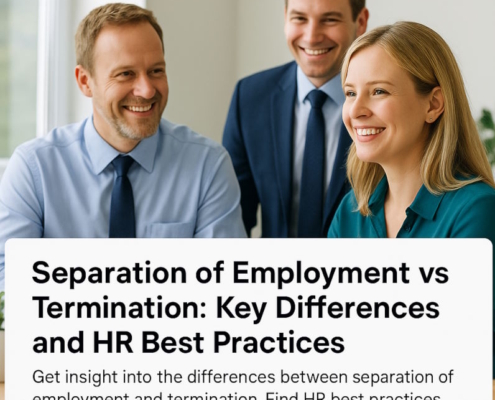Understanding the Various Differences between Full-Time and Part-Time Work
In many cases, the distinction between full-time and part-time work extends beyond the actual hours done each week. Businesses should go the extra mile to accommodate part-time arrangements in their time-tracking and payment systems.
You can better distribute tasks among your team members if you have a current job analysis and know how hiring a full-or part-time worker will affect the way you work.
Before deciding between part-time and full-time, employers should look at the job description. Is it possible to manage some responsibilities on a part-time basis? The company and the employee may feel pressured while trying to squeeze a full-time job into a part-time role. A work-life balance or limited free time are common reasons why people select for part-time employment. They might not be willing or able to put in the additional time that is required.
Another possible distinction between full- and part-time employment is the ability to receive benefits. Depending on the advantages, companies must adhere to the relevant rules and regulations. Below, we’ll go into more depth about how this can include the Affordable Care Act (ACA) and the Employee Retirement Income Security Act of 1974 (ERISA).
What Does It Mean to Have a Full-Time Job?
Workers that put in the full eight hours per day are known as full-timers, and their job description is exactly what it sounds like. A full-time job, according to the BLS, is one that requires 35 or more hours per week. However, under the ACA, a full-time job is one that requires 30 or more hours per week on average.
Before hiring full-time workers, businesses should think about:
The FLSA and state laws both require employers to offer certain benefits, like Social Security and Medicare, unemployment insurance, workers’ compensation insurance, and paid time off. Some of these legal protections may be available to part-timers as well, even though they are usually reserved for full-timers. In the event that an employee sustains a work-related illness or injury, workers’ compensation will cover their medical expenses and lost income. In the case of part-time employees who were involuntarily let go, state unemployment benefits may provide partial payments.
Better medical, retirement, and vacation plans, as well as opportunities for professional growth and self-employment, are all components of more all-encompassing benefits packages for employees. If at least one full-time employee uses a premium tax credit to purchase coverage in a government marketplace, the employer might face an assessment under the Affordable Care Act (ACA) for failing to provide full-affordable and sufficient health insurance benefits.
What Does It Mean to Have a Part-Time Job?
The standard workweek for full-time employees is 35 to 40 hours, although part-timers often work reduced schedules.
Nonetheless, part-time work is defined by both the BLS and the IRS. The Bureau of Labor Statistics (BLS) uses a range of 1–34 hours per week as its definition of part-time employment. Conversely, for the purposes of the ACA, full-time employment is defined by the IRS as working an average of at least 30 hours per week.
To qualify for overtime compensation, employers must keep track of the hours worked by part-time employees. Overtime is defined under the Fair Labor Standards Act as any hours worked by non-exempt employees above 40 per week. Workers are eligible for time and a half for every hour worked in excess of 40 hours per week. Due to their lower hours, part-timers seldom qualify for overtime. However, there are exceptions, such as when part-timers fill in for absent coworkers or work extra shifts during peak seasons like the holidays.
Lastly, in most cases, full-time employees get more benefits than part-timers. It should be very clear in your employee handbook which perks are available to full-time workers and which are available to part-timers. Employees and businesses alike can reap the benefits of part-time work due to the flexibility it provides.
How Does a Part-Time Worker Differ from a Full-Time Employee?
According to federal, state, and municipal rules and regulations, as well as work duties and expectations, employers often determine whether an employee is part-time or full-time.
Hours Worked Part-Time vs. Full-Time
The nature of the work and the time needed to complete tasks are two factors to think about when deciding whether a position calls for full-or part-time commitments. Be mindful that many workers may require a flexible work schedule to manage childcare or other family obligations in addition to their full-time job, as a result of workplace changes brought about by the COVID-19 epidemic. A few employees may be working less hours on purpose, while others may be doing so because they are unable to secure a full-time job in their preferred industry.
How many hours is part-time work?
How many hours a part-time worker puts in often differs from one business to another and even from one sector to another. The United States Bureau of Labor Statistics classifies part-time work as working between one and thirty-four hours per week. For the majority of businesses, a work schedule of 30–35 hours per week is considered part-time.
Naturally, businesses need to keep in mind that the ACA considers an employee to be full-time if they work 30 or more hours a week on average.
When is a job considered full-time?
Contrarily, 35 or more hours a week is considered full-time. Working 35 or more hours per week is considered full-time according to the United States Bureau of Labor Statistics. But let us not overlook the Affordable Care Act. The Affordable Care Act defines full-time work as 30 or more hours per week on average.
To determine if an employee is eligible for part-time or full-time benefits, employers must keep meticulous account of their workers’ hours worked.
Benefits for Workers
There may be differences in the benefits provided to full-time and part-time workers. Benefits for part-time workers may be required by federal, state, or municipal law.
Typically, additional perks, like fringe benefits, are up to the employer to decide. As an illustration, a company may offer part-timers less vacation time than full-timers.
Just as with full-time workers, offering fringe benefits can help bring in and keep part-timers. Businesses should research the labor market to find out what perks part-timers want and need at the lowest possible cost.
Needs for Health Insurance
Health insurance exchanges run by the federal government or individual states are available to “applicable large employers” (ALEs) under the Affordable Care Act (ACA).
In the event that the ALE does not provide its full-time employees with affordable coverage that satisfies the minimum value and one or more of these employees obtain health insurance through the marketplace and receive a premium tax credit, the organization may still be subject to a second type of penalty, even if the offer-of-coverage threshold is satisfied.
In general, according to the ACA, an ALE is a business that has an average of fifty or more full-time workers (including full-time equivalents) in the previous calendar year. It is critical to review your present workforce to guarantee compliance with the ACA, as full-time is defined as 30 hours or more per week (or 130 hours per month) on average.
Calculating full-time equivalent employees (FTEs) also requires factoring in the hours spent by non-full-time workers, such as part-time workers. Add up all the hours worked by all the part-time workers for the month, but don’t count more than 120 hours for each worker. For each month of the year, divide the sum by 120 to get the number of FTEs.
Health insurance is not a requirement of the ACA for smaller firms that are not ALEs. Alternatively, businesses can assess their workforce and objectives to determine the pros and cons of providing health insurance to both full- and part-time workers.
Differences in Taxes Paid to Part-Time and Full-Time Workers
When deciding between full-time and part-time personnel, remember that payroll taxes must be deducted from each employee. It makes no difference to companies how much time their employees put in; they are still required to pay federal income taxes, Medicare taxes, and Social Security taxes. It is also necessary to deduct any applicable employment taxes from the paycheck. Workers’ compensation regulations are applicable even to those who work part-time.
In order to differentiate between full-time and part-time workers, documentation is crucial. Establishing clear job classifications, such as full-time vs. part-time, aids in preventing future legal action and guaranteeing uniform application of internal regulations throughout the organization.
Differences in the Law Regarding Part-Time and Full-Time Workers
In most cases, employers get to decide how to classify their workers as either part-time or full-time, unless certain employment rules specify otherwise. For instance, as indicated earlier, the Affordable Care Act may treat a part-time worker as full-time if they put in 30 or more hours per week on average. If any one of an ALE’s full-time workers qualify for a premium tax credit, the business can face fines for failing to provide them with reasonable and sufficient coverage.
ERISA also allows part-time employees who put in 1,000 hours a year to participate in retirement plans offered by their employers. Certain long-term part-time employees who work at least 500 hours per year for two consecutive years are now required under SECURE Act 1.0 and 2.0 to be able to participate in workplace retirement plans.
Comparing Part-Time and Full-Time Jobs
Positions should be structured to address the demands of the company in light of the skills and knowledge that candidates will bring to the table. The decision-making process may also take into account the benefits and drawbacks of providing full-time vs. part-time work. Take into account the following:
Benefits of Working Part-Time
- When businesses are having trouble filling full-time positions, they may attract a larger pool of qualified candidates by increasing the number of part-time openings they post.
- Meeting targeted recruiting goals: People with particular skills who are unable or unwilling to work full-time may apply for part-time jobs.
- As a result of fewer hours worked, the employer may save money on pay, taxes, and benefits. Another way to reduce the cost of overtime is to use part-time workers.
- Time savings: If you can get your work done on a reduced timetable, a part-time employment could be the way to go.
Working Part-Time and Its Drawbacks
- Limitations on time: Working fewer hours each week could make it difficult to get everything done on time. It may be necessary to reschedule due dates in order to work with part-time employees.
- Logistics of scheduling: link part-time schedules to your time and attendance system so you can keep tabs on them just like your full-time schedules.
- A part-time worker may not be able to save as much money as a full-time worker who is able to manage more tasks since they are still eligible for benefits like health insurance even when they work fewer hours.
- Effect on morale: If your workers’ work schedules are less predictable, they may feel less invested in their work and provide subpar results.
Benefits of Working Full-Time
- Dedication: Regular employees may have more chances to show how much they value the organization.
- In terms of recruiting, full-time jobs may be more appealing to those who are looking to advance in their careers.
- Convenience in scheduling: compared to having employees work variable reduced schedules, a full-time workforce could mean fewer personnel for the business to keep track of.
Drawbacks of Full-Time Work
- For full-time employees, employers pay a higher premium for workers’ compensation in order to cover extra hours worked, benefits, and overtime.
- Proficiency level: Companies may find themselves constrained in their hiring choices if talented people want to work part-time.
The Cost of Part-Time vs. Full-Time Staffing
Think about how much money your company will lose or make as you compete for top talent. Hiring part-timers, for instance, could save you money on compensation and benefits compared to full-timers. This is because part-timers usually put in less hours and get fewer perks. You may reduce your out-of-pocket expenses for benefits management including retirement, health insurance, FSAs, leaves, and PTO by investing in part-time workers.
Conversely, full-time employees can end up costing you more in wages and benefits. You may also put more money into your full-time employees’ professional growth, license, and training. The financial line may benefit, though, from the increased engagement and loyalty of your full-time employees.
Evaluating the Efficiency and Productivity of Part-Time vs. Full-Time Workers
One may ask if full-time and part-time employees are any different in terms of efficiency and output. Both forms of work have their benefits and drawbacks in these respects, as one would anticipate. Here’s how the two stack up:
Part-time employees:
- Enables filling in shortages in workforce or skill sets.
- Could feel more energized after cutting back on hours, which would allow them to get more done at work.
- Might experience less stress as a result of reduced working hours, which might lead to less burnout and more productivity.
- Could help the company save money, which would be great for their bottom line.
- Potentially causes high turnover and extra expenses for the organization due to lack of engagement or commitment.
Full-time employees:
- Reduced adaptability might make it harder to fill open positions and train new employees.
- May show less turnover and more dedication as a result of full-time pay and better benefits, which might lead to improved efficiency and production.
- May have more fulfillment from their work, leading to increased output.
- More responsibility and less autonomy in full-time jobs may lead to more burnout. The worker’s effectiveness, productivity, and output may suffer as a result.
Deciding Between Part-Time and Full-Time Workers
The nature of your sector and the specifics of your organization will dictate the optimal staffing levels for your company. Talk to your HR professional about what kind of employees would be a good fit for your small business if you’re not sure where to begin.































